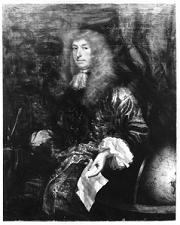<Back to Index>
- Explorer Jean Chardin, 1643
- Author Peter Andreas Heiberg, 1758
- King of the Wawaiian Islands Kalākaua, 1836
PAGE SPONSOR

Jean Chardin (November 16, 1643 – January 5, 1713), born Jean-Baptiste Chardin, and also known as Sir John Chardin, was a French jeweller and traveller whose ten volume book The Travels of Sir John Chardin is regarded as one of the finest works of early Western scholarship on Persia and the Near East.
Chardin was born in 1643 into a Protestant family. His father, a wealthy jeweller, gave him a good education and trained him in the jewellery trade. But instead of settling down in the family profession, the young Chardin set out with a Lyon merchant named Antoine Raisin in 1664 for Persia and India, partly on business and partly to gratify his own wanderlust. After a successful journey, during which he had received the patronage of the Safavid monarch Shah Abbas II, who died in 1666 and his son Safi Mirza succeeded him first as Shah Safi II then as Shah Suleiman I, Chardin returned to France in 1670. The following year, he published an account of Le Couronnement de Soleïmaan (English translation: The Coronation of Shah Soleiman).
Chardin found, however, that his Protestant faith cut him off from all hope of honors or advancement in his native France, and so he set out again for Persia in August 1671. This second journey was much more adventurous than the first. Instead of going directly to his destination, he passed by Smyrna, Constantinople, the Crimea, Caucasia and Georgia, and he did not reach Isfahan till June 1673. After four years spent travelling in Persia, he again visited India, and returned to Europe by the Cape of Good Hope in 1680.
By this time, however, Louis XIV's persecution of French Protestants was in full swing, and in 1681 Chardin left his homeland yet again, this time to settle in London. There he was appointed jeweller to the royal court. Charles II granted him the honour of knighthood, and on the same day Chardin married Esther de Lardinière Peigné, a Huguenot refugee from Rouen. They had seven children together. The Royal Society elected him a fellow in 1682.
Chardin then spent some time in Holland as representative of the English East India Company. In 1686, he published the first part of his famous Travels (Account of his Second Travel to Persia). But it was not until 1711 that the complete work was published, from Amsterdam, under the splendid title Voyages de monsieur le chevalier Chardin en Perse et autres lieux de l'Orient (English: The Travels of Sir John Chardin in Persia and the Orient).
Sir John died in Chiswick,
London in 1713. He was buried in Turnham Green (Chiswick), but there is a funeral monument for him in Westminster Abbey that bears the inscription nomen sibi fecit eundo. Modern scholars consider the 1811 edition of Voyages (edited by the Orientalist Louis-Mathieu Langlès)
to be the standard version. The complete book has never been translated
into English; in fact, English language versions contain less than half
of the original material. Early readers commended Chardin's work for
its fullness and fidelity, and he received praise from a number of Enlightenment thinkers, among them Montesquieu, Rousseau, Voltaire and Gibbon.
Latter day scholars of Persia also vouch for his importance; according
to John Emerson, "his information on Safavid Persia outranks that of
all other Western writers in range, depth, accuracy, and
judiciousness." Chardin travelled far and wide, had a good command of
the Persian language, and left detailed accounts of the places and
people he encountered. He also had direct access to the Safavid court,
and his descriptions of contemporary politics and administration are
highly regarded. Although there are occasional lapses in his books, he
is generally trusted as a reliable witness, and his work has been used
as a source for diverse studies on Safavid history, government,
economics, anthropology, religion, art and culture.